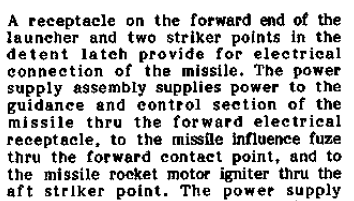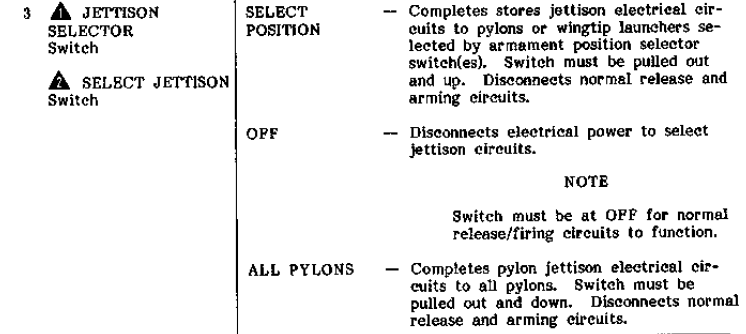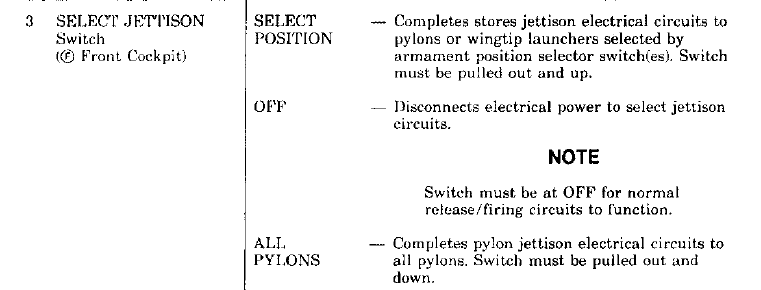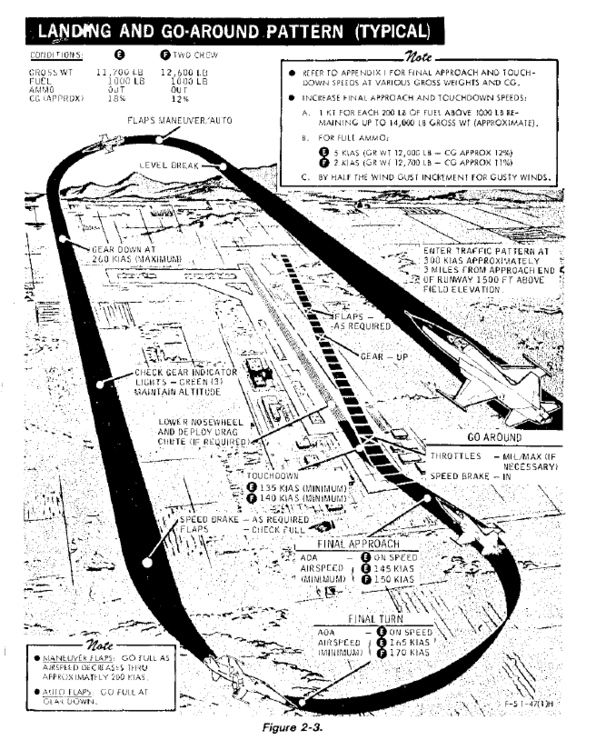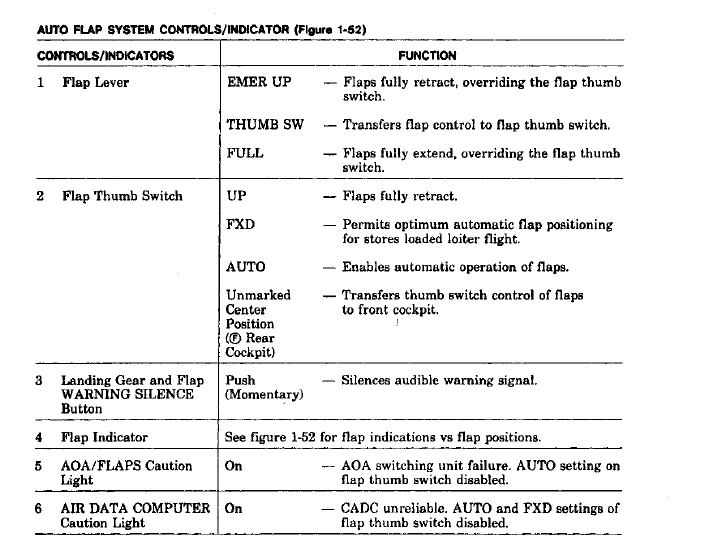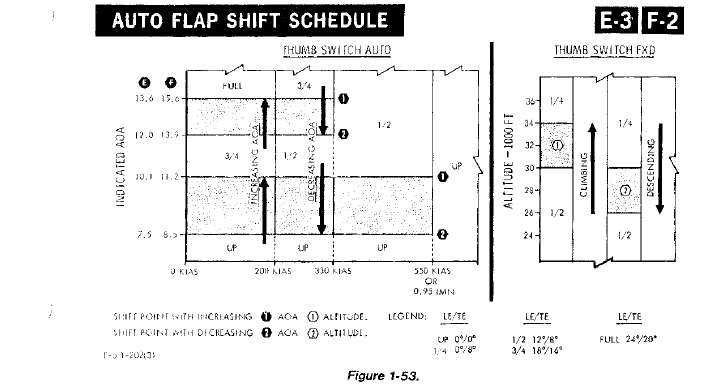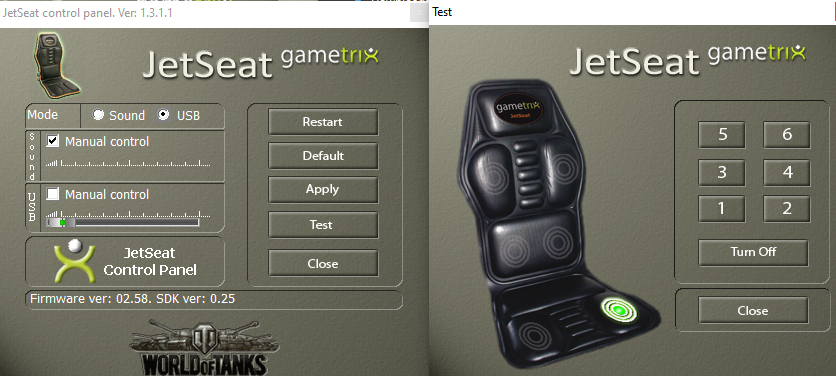

nairb121
Members-
Posts
135 -
Joined
-
Last visited
Content Type
Profiles
Forums
Events
Everything posted by nairb121
-
I read deeper into the -34 and it's become clear that the left sidewinder doesn't follow the weapon selection rules as expected. It actually appears to be correct for it to produce a growl when deselected or when the External Stores selector is out of SAFE - if this is the case, I believe it's likely it will also ignore the jettison switch position. Has this particular issue been tested to determine if the left and right missiles behave differently? (I hope whoever fixed the "bug" didn't delete the old code...)
-
The thread above was concerning a reported bug where the sidewinder growl would continue with the missiles not selected. It was later determined that the left missile was the source of the problem. However based on this section (Figure 1-28) in the -34 (https://www.digitalcombatsimulator.com/en/files/1946809/) it appears that it's correct for the left AIM-9 to growl regardless of selection, as long as the Guns, Missile, and Camera switch is set to GUNS MSL & CAMR and there is a missile on the station. However, the the volume knob should still control the volume of the audio tone. This will also be the case when the External Stores selector is out of the SAFE detent - the missile cannot be fired but the left AIM-9 will still produce an audio tone. Selecting DM or DG mode should allow the missiles to be fired and (I assume) the right missile to be heard, regardless of the External Stores selector position. It's not clear why the left launcher behaves differently. The only difference appears to be the left launcher's provisions for the TDU-11/B target rocket - maybe something about this implementation causes the unexpected behavior.
-
Reading the -34 (https://www.digitalcombatsimulator.com/en/files/1946809/), I'm definitely leaning towards the growl being incorrect when the select jettison switch is moved out of OFF. It specifies that the AIM-9, when jettisoned, is launched unguided - meaning the seeker should be inactive. Additionally, it notes the select jettison switch as disabling normal release and arming circuits - so it should be expected that the seeker and fuze are unpowered when the switch is moved out of the OFF position. The section on the wingtip launch rails indicates that there are 3 connection points to the missile, one for the guidance/control section, one for the fuze, and one for the motor. It seems likely that when jettison is selected, the guidance and fuze sections are unpowered and only the motor igniter is powered.
-
Note that the 1977 manual is for the earlier F-5E and not the F-5E-3 variant we have - the 1984 F-5E/F manual (https://docdro.id/51orrvC) incorporates all E/F variants up to E-3 and F-2. In this case it doesn't matter much (there is a slight difference in the armament panel, but not relevant to selective jettison) but there are some changes that are significant.
-
Has any tester been able to reproduce this yet? Is there any additional information I can provide?
-
What sort of AoA numbers are you testing this at? In my experience, at higher AoA (over 20 units or so) you statement seems to accurately describe its behavior in DCS - the ailerons become ineffective and rudder is necessary to control roll.
-
Yeah the problem is not that the plane is fragile, it's that it's trivially easy to pull 12g in a simulator, when in reality it takes a massive amount of stick force (like 50-60lbs). Just be careful if you're fast and you'll be fine. It would be nice to have some sort of option to simulate pilot strength limits, so it's "harder" to pull at higher speeds, but I'm not sure how that would work. Maybe just reduce sensitivity away from center as speed increases? Not sure how well that would work, just thinking. Sadly I can't pay 10k for a realistically strong FFB stick.
-
Engine overspeeds by an extreme amount when advancing throttle to afterburner immediately after spawning in air. To reproduce: 1. Spawn in air with throttle in MIL or below. 2. Immediately advance throttle to MAX. 3. Engine hangs at ~85% RPM, temperature climbs rapidly. Afterburner does not light. 4. Reduce throttle to MIL. Engine increases to 100% and overshoots significantly, to almost 200% RPM, with excessive thrust and fuel consumption. 5. Engine after some time slows back to 100%. The duration of this overspeed seems to be proportional to the time held at MAX prior to reducing to MIL. I believe I have encountered this overspeed issue in other situations, but I have only been able to reproduce it in this manner. Track is attached. F-5 engine overspeed.trk
-
The -1 notes speed brake on approach variously as "as required" or "as desired", which suggests to me that its use is optional, either based on pilot preference or squadron procedures. Speed brake usage is not elaborated on further other than what is shown in the diagrams.
-
Note that this is for the manuevering flaps installed in the F-5E, E-1, and E-2, and the F-5F and F-1. The section on the AUTO flaps installed in the E-3 and F-2 is slightly different. I agree though that manually setting flaps up at best does nothing at low AoA, and at worst reduces the L/D ratio at high AoA, increasing speed loss rather than decreasing it, for a given turn outcome. The only times, in my opinion, that flaps should not be set to AUTO are in cruising or formation flight (UP or FXD depending on speed and weight), to avoid transient effects. Outside of emergency situations there is no need at all for any setting on the flap lever other than THUMB SW, as the flaps automatically reposition to FULL with the landing gear deployed.
-

Force Feedback stick force unaffected by airspeed
nairb121 replied to nairb121's topic in Bugs and Problems
Public-release unlimited distribution document linked below provides data on the F-5's longitudinal feel characteristics and loads, starting on page 151 (numbered in document as 122). Of particular note are the charts showing measured stick force per g at various speeds and configurations on 169-171 (numbered in document as 140-142). https://apps.dtic.mil/sti/pdfs/AD0738625.pdf -
The F-15's artificial feel system isn't like a lot of other planes. The stick force per displacement doesn't change significantly based on airspeed - instead the stabilator linkage is geared to airspeed such that the stabilator deflection is reduced at higher airspeed for a given stick force/displacement, in order to maintain proportional force per g. Might be a little weirdness from the CAS but for the most part there should be very little change in the stick feel, only the response of the aircraft.
-
I'll send you a DM so we don't derail this thread any further.
-
Are you sure CLS2Sim is properly connecting to DCS? It should show in the CLS2Sim window, once you're in a mission, that it's connected and receiving information. Otherwise you'll need to check and make sure the DCS plugin is properly installed.
-

Force Feedback stick force unaffected by airspeed
nairb121 replied to nairb121's topic in Bugs and Problems
BrunnerDX is an external program that uses an Arduino to interface between DirectInput and CLS2Sim, allowing DCS's native force feedback to work with Brunner hardware. I've been using the CLS-E with CLS2Sim in DCS for a couple years, and have only now been able to test the native implementation via BrunnerDX. This is indeed the behavior of DCS's native FFB implementation. -

Force Feedback stick force unaffected by airspeed
nairb121 replied to nairb121's topic in Bugs and Problems
It's a Brunner CLS-E. I normally use Brunner's CLS2Sim software, since Brunner doesn't natively support DirectInput FFB, but I recently got BrunnerDX working and wanted to try it out with the F-5E. Until this is fixed though, I'll probably just keep using CLS2Sim instead. -
Here's my F-5 profile, you're welcome to give it a try if you like. F-5.zcs
-
CLS2Sim uses a vJoy device to receive FFB effects from DCS, that's how modules with FFB support (like the F-14 for example) can send shaker effects. It only does effects though, not stick position or force, which is why it uses its own internal trim rather than DCS's. The F-5's FFB implementation doesn't provide any shaker effects that I'm aware of, all it does as far as I know is basic recentering, trim, and the aileron limiter at 50% lateral deflection.
-
When flying the DCS F-5E with a force feedback stick, the forces on the stick remain constant for a given displacement regardless of airspeed. This is inaccurate - the F-5E has an artificial feel system which should provide longitudinal (pitch) stick forces proportional to g. Increased airspeed results in more g for a given deflection - therefore stick forces should be higher at greater airspeeds.
-
Sure. Testing it with settings as below, I couldn't tell any difference in the intensity. I clicked "Apply" after the changes, not sure if that matters or not. I also tried checking the "Manual control" box and clicking "Apply", then adjusting the knob on the controller, but again, I couldn't tell a difference. EDIT: I tried the Russian Gametrix software instead, and that seems to have fixed it. Thank you! However, I also realized during testing that motor zone 2 was not responding. I can't find any damaged or disconnected wires. I measured the voltage between the pins at that connection though, and measured 0 voltage with those motors in test. Zone 1 worked in test, and measured 9 volts at my current setting, so I don't believe it's a measurement error, or an issue with the wiring or motors. Is it feasible to repair this, or will the board need replaced?
-
I'm having some trouble adjusting the intensity on my Jetseat - I can't tell any difference between minimum and maximum setting in the Jetseat control panel, or in manual with the controller adjustment. Is this normal, or is something wrong?
-
Yeah, I definitely agree with you here. I get confused enough with the airspeed/stick pull/g relationship, CG stuff isn't something I have any desire to worry about. It wouldn't surprise me either if DCS inputs already accounted for that anyway.
-
G forces are not involved since no artificial feel is required for G forces in the real thing. I might not have worded this as clearly as possible. Most sources I've found seem to indicate "constant stick force per g". I ended up finding this patent, U.S. Patent #2661169, relating to early artificial feel systems (in this case, actually granted to Northrop Co.). Relevant quotes: nullIt also included this figure, showing stick force vs. deflection at various airspeeds: Although the aircraft configuration is different, and the mechanism had likely changed by the time the F-5 was designed, it seems reasonable to me that the overall design philosophy (i.e. constant force per g) would be maintained. I was unclear here as well, I meant fore-and-aft stick movement, i.e. pitch.
-
Aircraft with hydraulic boosted controls don't give the pilot direct feedback from the control surfaces, like mechanical linkages would. They generally include some system to simulate that "feel", referred to as "artificial feel". Without that feedback, it's difficult to accurately control the inputs you're making. So really, using FFB in DCS is artificial artificial feel. Unfortunately, my stick (Brunner CLS-E) doesn't support the DirectInput force feedback API (maybe it's time for me to pester them about it again), so I can't easily use ED's implementation. I'm mostly restricted to a force vs. deflection curve, with an additional multiplier based on airspeed. There are a few other variables, but I'm mostly trying to figure out how to dial in the airspeed multiplier curve. Educated guess or not, this is really helpful, since it at least gives me a starting point for looking into these systems. It looks to me like (at least for longitudinal controls) it's generally expected that stick force will be proportional to g. I might have to do some math at some point, but I think this should at least get me headed in the right direction.






